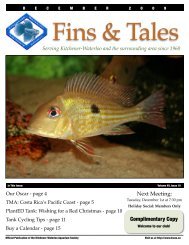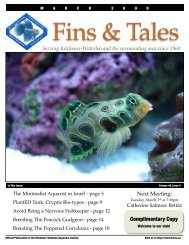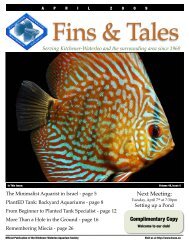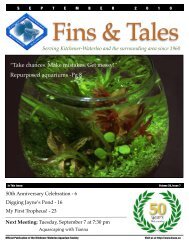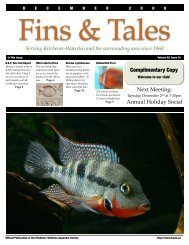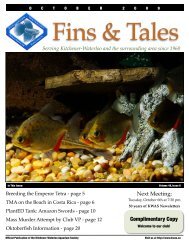June 2009 - Kitchener Waterloo Aquarium Society
June 2009 - Kitchener Waterloo Aquarium Society
June 2009 - Kitchener Waterloo Aquarium Society
You also want an ePaper? Increase the reach of your titles
YUMPU automatically turns print PDFs into web optimized ePapers that Google loves.
J U N E 2 0 0 9<br />
source to grow anything in the way of aquatic plants. So,<br />
knowing your light source will now give you some choices of<br />
what plants can be grown in your tank. Most plants are<br />
considered low, medium or high light. Low light is usually<br />
considered anything less than 1.5 watts per gallon (wpg) of total<br />
light source compared to the size of your tank. Medium light is<br />
between 1.5 and 2.5 wpg and high light would be anything<br />
more than 2.5 wpg. Also consider that you will lose some light<br />
if you have a glass top over your tank and the deeper the tank<br />
the less light will penetrate to the bottom. The amount of time<br />
that you have the lights turned on each day will also be a<br />
determining factor.<br />
the LFS staff might ask to help you in selecting your plants.<br />
“What kind of substrate do I have?” This can make a difference.<br />
Many people have gravel in their tanks but the size can make a<br />
difference when choosing plants. If the gravel is too coarse, fine<br />
or shallow rooted plants will have a difficult time establishing<br />
themselves and may not survive. If your substrate is too<br />
shallow, deep rooted plants will not have enough room to be<br />
planted and stay in place. If you want to grow plants at<br />
optimum conditions you may even want to change your<br />
substrate to some of the newer products such as fluorite or<br />
“Eco-Complete”. Water quality can also be a factor. Some plants<br />
need soft water to grow properly while others don’t care. Other<br />
plants need fertilizers or CO2 added to the tank to flourish.<br />
These are things that you may or may not want to invest in so<br />
will also determine whether you want to spend money on some<br />
varieties of plants. Even the size of your tank can be a factor. If<br />
you have a 10 or 15 gallon tank that is 12 inches high, it doesn’t<br />
make a lot of sense to buy a plant that will grow 20 inches tall.<br />
The second question to ask is what kind of fish are you<br />
keeping? If you have silver dollars for example, the answer is<br />
easy – go look at the plastic plant section because silver dollars<br />
will eat most plants. If you are keeping large Central or South<br />
American cichlids, you may find that they love to tear up and<br />
uproot pretty much any plant you get. African cichlids can be<br />
tough on some plants as well. Goldfish and koi are also known<br />
for uprooting or chewing plants down to nothing. It doesn’t<br />
make a lot of sense in trying plants in tank settings that may be<br />
doomed from the start, but there is no hard and fast rules that<br />
say that rules can’t be broken and experiences can differ. Even<br />
silver dollars which are notorious plant eaters can live in a<br />
planted tank if you chose the right species of plants. Java fern<br />
actually produces a substance within its leaves that makes it<br />
unpalatable to fish and can be grown in the same tank with<br />
herbivores. The type of fish you have may also steer you to the<br />
type of plants you might want as well. If you are keeping<br />
livebearers you might want floating plants with bushy leaves to<br />
protect new fry. If you are keeping tetras you might want fine,<br />
soft leaved plants that will still allow the fish to show off their<br />
colour. If you are looking to set up a bio type you may want to<br />
match fish and plants from the same geographical region. These<br />
are things to consider.<br />
You will have been able to whittle down your initial choices a<br />
bit but there are a few more questions that you can ask – or that<br />
Now, you have some answers to help make your plant<br />
purchases much easier. You are primed and ready to go. What<br />
comes next? Well, a trip to your LFS is in order. You have likely<br />
made many purchases there before and hopefully staff will<br />
remember you and you have established a rapport with<br />
someone. Hopefully they keep fish and plants themselves. Ask<br />
them what they keep to find out a bit of their experience. Look<br />
over the selections of plants in the store and discuss what you<br />
are looking for and what your needs and limitations are. If you<br />
see a plant that you like and you aren’t sure if you want to buy<br />
it, take down the name. You can do some research and find out<br />
whether it is for you or not.<br />
Things To Look For<br />
As you are shopping for your plants there are some basic things<br />
to look for that could help. Take notice at how long plants have<br />
been in the store. This should help tell you if plants are moving<br />
or not. A good store should replenish their stock to replace<br />
plants and bring in different species. If there is something you<br />
15





